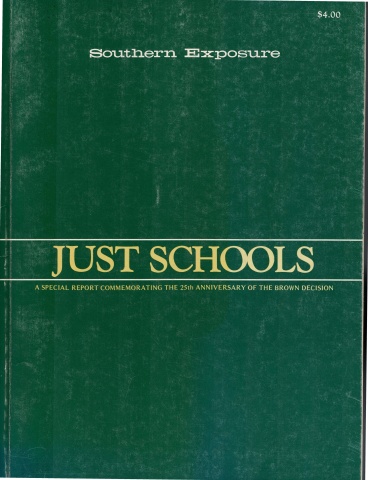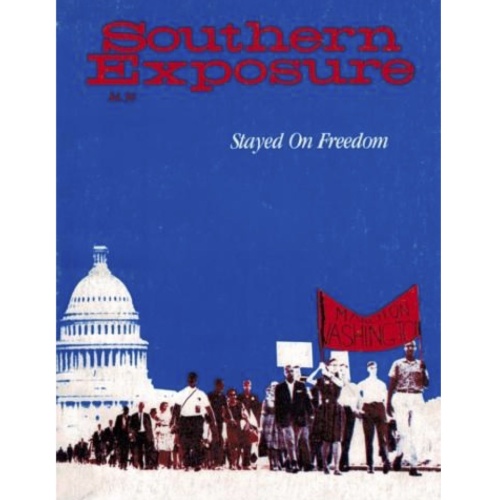New Orleans 1960-1979

This article originally appeared in Southern Exposure Vol. 7 No. 2, "Just Schools: A Special Report Commemorating the 25th Anniversary of the Brown Decision." Find more from that issue here.
A second Battle of New Orleans erupted in 7960 when the city's public schools were ordered to desegregate. For months, a newly elected conservative governor, Jimmie Davis, and a segregationist state legislature vigorously fought the courts and eventually the Orleans Parish School Board in an effort to seize control of, bankrupt, close down, or otherwise prevent even token integration of the city's schools.
“If they [the federal courts] can do everything they are trying to do, "bellowed Governor Davis, "this state no longer has its sovereignty."
Since local and state officials failed to submit their own plan of desegregation, the court imposed its own: a system of grade--a-year pupil assignment that allowed students, beginning with first graders, to apply to the closest previously all-white or all-black school to their home; the school board, using its own criteria, but without regard to the race of student, would accept or reject the applicant's first choice.
The reluctant school board ultimately established 17 "scientific" and "objective" criteria designed to shield itself from attack by conservatives who were demanding that it close down the schools altogether. The system the board devised, however, couldn't have been better fashioned for failure. Believing that black children were not intellectually ready to attend white schools, it chose two schools with low median student scores for its plan of token integration. Both schools, McDonogh No. 19 and William Frantz Elementary, are in one of the city's poorest neighborhoods, the racially mixed Ninth Ward, where political organization, and therefore city services, are minimal. Neighborhood whites doubly resented the choice as another indication of the city's indifference toward the area.
To find the "right" tokens, the school board administered intelligence tests to the 136 black applicants seeking to attend white schools, and screened their families for "moral standing. " Four girls were selected. On November 74, 1960, escorted by U.S. Marshals, three six-year-olds entered McDonogh 19 and one entered Frantz, greeted by mobs of screaming, spitting, cursing, stone-throwing whites.
Only a few white students attended Frantz that day, and none went to McDonogh. On November 7 5, at a rally sponsored by the White Citizens Council, Leander Perez, the legendary boss of neighboring Plaquemines Parish, told a crowd of 5,000, "Don't wait for your daughters to be raped by these Congolese. Do something about it now." The following day, a crowd of white teenagers and adults marched on the school board offices and federal judge's office, and before they were dispersed by city police, several blacks inside buses were hurt by flying glass from smashed windows, and two were seriously beaten.
For several months before the first day of integrated schooling, two white groups, Save Our Schools (S.O.S.) and the Committee on Public Education (C.O.P.E.), joined black parents and community leaders to rally support for keeping the schools open. But the attack from the right wing was virulent and consistent. The state legislature tried to take control of the schools, impounded funds to pay teachers, and fired the school board president and its attorney. The federal court continued to overrule the state and recognize the authority of the board to keep the schools open, but sporadic rioting and hostile demonstrations by whites also continued. The spectacle of violence broadcast through nationwide television shattered New Orleans' image as an oasis of racial tolerance in the Deep South. Tourism plummeted; in December, 7960, the New York Times reported a 20 percent decline in business in the city. Only then did the business and social elite denounce the demonstrators and call for law and order. Gradually, the physical and psychological tormenting of the integrators left the limelight and moved indoors.
By the time token integration had yielded to actual integration, most whites had fled for the suburbs, Catholic schools or segregation academies. (Leander Perez had invited the 1,000 white students from the Ninth Ward to attend his Parish schools, and by the end of 1960, nearly 600 were so enrolled.) Today, while New Orleans schools, now 85 percent black, continue to struggle financially, the state legislature is considering measures to provide tuition assistance to parents in private schools.
In 1960, psychiatrist Robert Coles began studying the affects of segregation and desegration on young children in New Orleans and Atlanta. His observations, including those excerpted below, formed the first volume
In his classic series, Children of Crisis. His portrait of Tessie Prevost, who integrated McDonogh 19, is followed by interviews with the Prevost family conducted in 1979 by Clare Jupiter.
-The Editors
Tags
Southern Exposure
Southern Exposure is a journal that was produced by the Institute for Southern Studies, publisher of Facing South, from 1973 until 2011. It covered a broad range of political and cultural issues in the region, with a special emphasis on investigative journalism and oral history.
